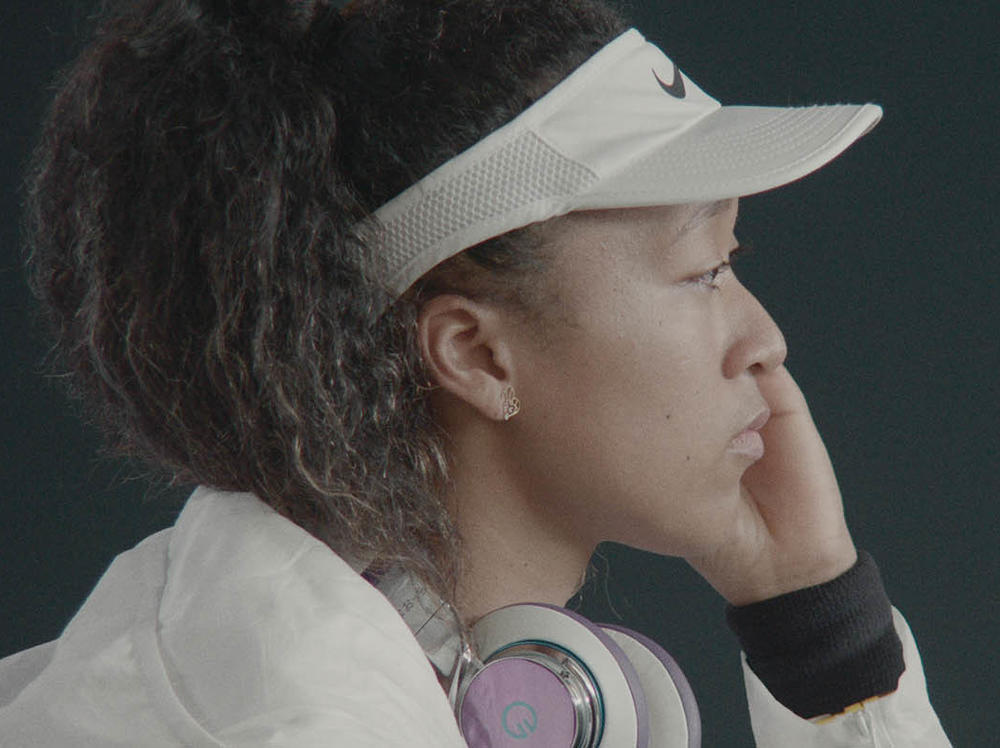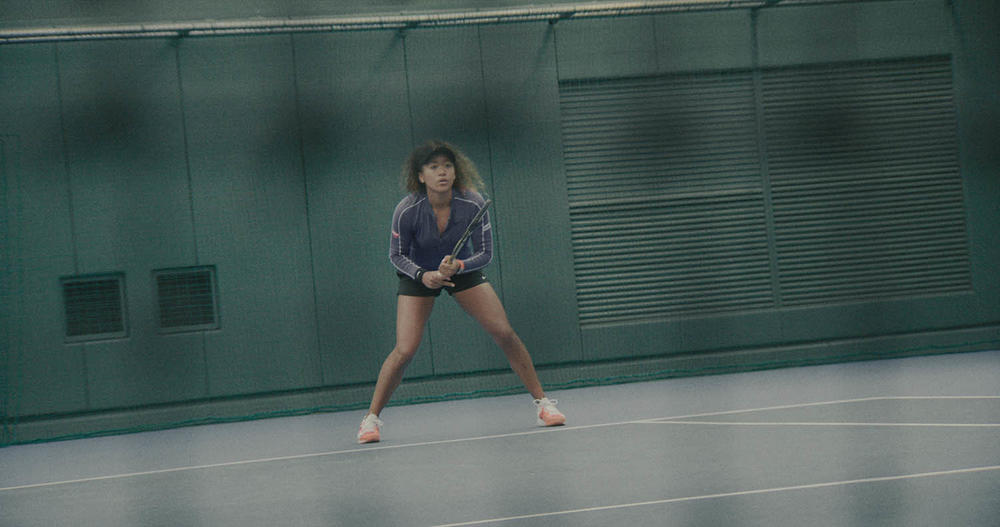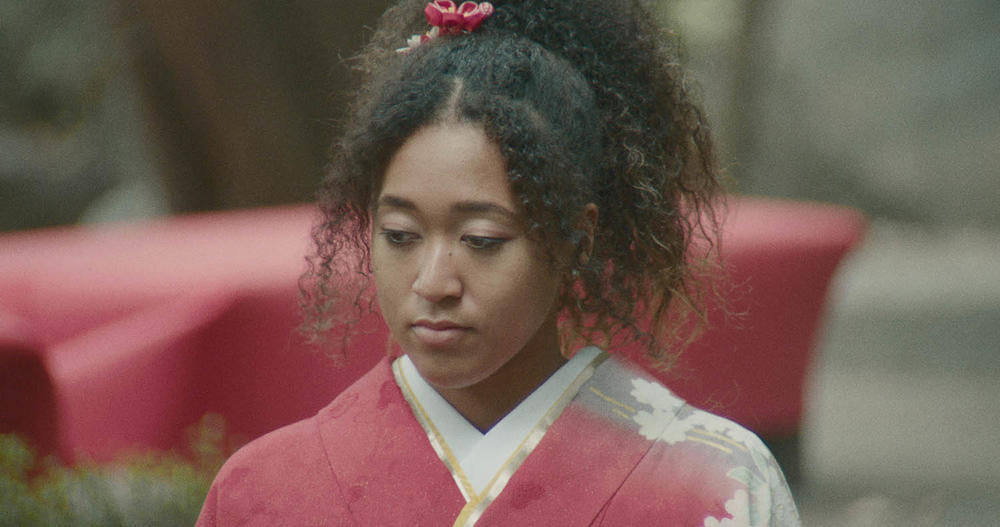Section Branding
Header Content
An Introverted Champion Reveals Her Earnest Heart In Netflix's 'Naomi Osaka'
Primary Content
One thing is obvious after watching Naomi Osaka, Netflix's three-episode docuseries tracking the life of the increasingly press-shy tennis champion.
Naomi Osaka worries. A lot.
She worries about the pressures of fame after her victory over Serena Williams in the 2018 U.S. Open made her a superstar. She worries about serving as a role model for biracial youth, as the daughter of a Japanese mother and Haitian father. She worries about random noises in her new home after moving away from her family. She worries about whether, as a citizen of Japan who represents the country as a championship player, she speaks Japanese well enough.
And, in one of the docuseries' most poignant moments, she worries if her mental mistakes on the tennis court betray her longtime mentor and friend Kobe Bryant, who died in a January 2020 helicopter crash.
"I'm feeling like I let him down," she tells her iPhone camera in one vulnerable scene, speaking through sniffles and tears. "I'm supposed to carry on his mentality in tennis, but here I am ... losing these matches because I'm mentally weak. Now I'll never have the chance to talk with him again."
In sharp contrast to the confident image many champion athletes present in public, Netflix's Naomi Osaka allows viewers to see in detail how the 23-year-old has struggled with notoriety, living up to status as the first Asian player to hold the top ranking in tennis singles, keeping up with the breakneck life pace required for one of the world's most successful and marketable athletes, and much more.
Explaining Osaka's media anxiety
The portrait these three, 40-minute episodes provide is of a shy, willfully intelligent, painfully perceptive young woman grappling with a sudden deluge of fame and success. It's also one of the best arguments yet for Osaka's decision earlier this year to step away from post-game press conferences to protect her mental health.
Watching how intensely she worries about so much, revealing her thoughts through introspective monologues, it is easier to understand why she refused to participate in press conferences during the French Open in May, despite a $15,000 fine and threats she might be disqualified. Eventually, she withdrew from both the French Open and Wimbledon championships; in an Instagram post, Osaka wrote about her social anxiety and suffering bouts of depression after her U.S. Open win in 2018.
Curiously, the docuseries doesn't capture much of this anxiety over press conferences. We mostly see professional journalists asking pertinent questions respectfully, which Osaka handles with a practiced reserve and shy grace. And there isn't an attempt to address the massive controversy over her decisions about speaking to the press, which likely happened after filming concluded.
But the docuseries does show an emotional moment from the U.S. Open in 2019, when Osaka grew emotional after defeating 15-year-old Coco Gauff. She encouraged the young player to join her in the post-match interview on the court, both players in tears over the intensity of the moment. (Ironically, the docuseries would also document how Gauff beat Osaka during the Australian Open months later in January 2020.)
Osaka displays the peculiar combination of sheltered naivete and worldly experience sometimes seen in successful sports prodigies who have spent their entire lives focused on their sport. In one moment, she's reflecting on the politics of becoming a Japanese citizen despite living and training in America — the next, she's unsure whether typical twentysomethings her age are still in college.
Throughout the docuseries, Osaka is struggling to answer a central question: How can she be the kind of fierce competitor she needs to be, while also staying true to herself as a human being?
Plunging viewers into Osaka's world
Director Garrett Bradley, an Oscar nominee for the poignant 2019 documentary Time, spent two years filming Osaka during crucial moments. Bradley creates an immersive experience aimed at making viewers feel what it is like to be with Osaka as she moves from one challenge to another.
Opening titles are displayed above a blur of motion, telegraphing how quickly Osaka's life moves now; locations where she is traveling are communicated by focusing on different clocks set to different time zones — New York, Los Angeles, Spain, Japan, and beyond. The sound of her tennis racket slamming into a ball echoes like a cannon shot; audio evidence of the power she summons on the court and the focus it takes to win a match.
Artful and telling as Bradley's presentation can be, it is tough for viewers who don't know tennis to get a sense of how much time has passed or when things are happening. Osaka's life is often rendered in a blizzard of media appearances, training sessions and matches, spiced by detours into her family and personal history.
The story of parents Tamaki Osaka and Leonard Francois – who faced challenges as a biracial couple in Japan and America – is an important, telling thread woven throughout the docuseries. It allows the tennis champion to talk about the tension between nationality and ethnicity, the importance of the Black Lives Matter movement and the effort to connect with the cultural heritage of both her parents.
As insecure as Osaka may seem in some moments, she can also make momentous decisions with firm clarity. That's shown here in her decision to wear face masks commemorating Black people killed by police while competing in the U.S. Open last year, reflecting an increased activism after the murder of George Floyd by a Minneapolis police officer.
Documentary as carefully curated access to celebrity
With loads of cooperation and access provided by Osaka and her family – including riveting footage taken by Francois of Naomi and her sister Mari learning to play tennis as small children – there is still a sense that this is a carefully curated look at the superstar. NBA legend LeBron James and his partner Maverick Carter serve as executive producers, continuing the feeling that they are helping a young sports phenom present herself to the world in the way that Bryant once did.
This is a question that often surfaces when regarding Netflix's docuseries centered on powerful celebrities, including projects starring Kevin Hart, Michelle Obama and Taylor Swift. How much control does a celebrity have and how much does that affect what we eventually see?
Still, Naomi Osaka does a masterful job connecting the personal journey of a tennis superstar to issues of race, nationalism, civil rights, modern media and the way athletes are marketed to the world.
Along the way, it brings the audience closer to an introverted champion ready to reveal much of her earnest heart to a waiting world.
Copyright 2021 NPR. To see more, visit https://www.npr.org.



